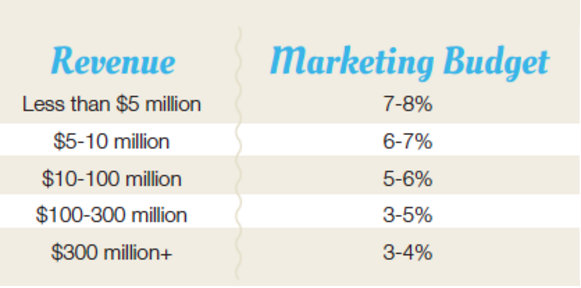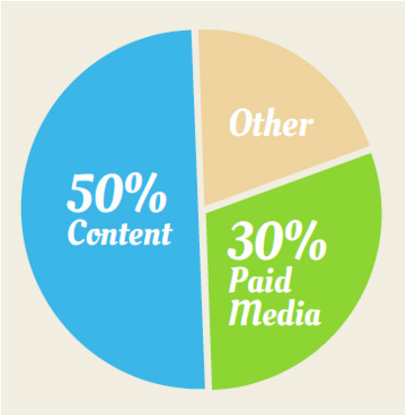So your organization is ready to jump into the content marketing game. Time to develop some delightful, helpful content, wait for the Internet to freak out, then pat yourself on the back when your sales team is bombarded with qualified leads, right? Well, not exactly.
Creating content that solves people’s problems and generates good vibes for your brand is half the task. Paying to distribute that content is the oft-underestimated—but critical—other half. Unfortunately, people aren’t hanging out on your website all day waiting for you to publish your latest nuggets of expertise. They’re busy, and they’re drowning in information. You have to find out where your audience spends time online and invest in placing your content in their line of sight. Otherwise you risk having those great assets go unseen and having to explain to stakeholders why your investment isn’t generating results.
So how do you budget effectively for both sides of the content coin, creation and distribution?
Benchmarks for setting your content creation budget
Based on the guidelines below from Scott Margenau, a company with $10 million in annual revenue should spend 6 to 7 percent, or $600,000, on marketing. Marketing organizations typically allocate 50 percent of their budgets—or in our example, $300,000—to content creation, according to McKinsey & Company. Let’s explore how you might spend that chunk of change.
Different content formats, different cost considerations
Some types of content are inherently more costly to produce. A single blog post might seem like a small investment, but a successful blog strategy requires ongoing content production, not a one-time expense.
Conversely, if you create videos or host webinars, you might only turn out one per quarter. But the investment required in technology, equipment, shooting and editing drives up the sporadic cost of producing a single offer.
Plan an editorial calendar for your content creation cadence (online and off) to anticipate the ongoing and one-time expenses involved in producing a variety of assets, and build these costs into your budget.
Key players on your content creation team
Brand journalist: Content is information, and you need strong writers to package it into compelling stories, be they bite-sized or book-length. These team members will research and write your blog posts, eBooks, video scripts, white papers and more. Median annual salary: $43,000.
Graphic designer: The best designers can take a lackluster document and make it more digestible and visually appealing, while also conveying your brand’s style and tone in everything you disseminate. Median annual salary: $41,000.
Videographer: Not everyone wants to learn by reading or scanning a spiffy infographic, and some content is just better suited to visual storytelling. For demos or instructionals that warrant showing rather than telling, you’ll need someone who can shoot and edit video. Median annual salary: $41,000.
Web developer: Your website is the hub of your communications, housing your blog and landing pages, along with your core messaging and product catalog. A web developer can handle the technical side of publishing content on your owned properties. Median annual salary: $56,000.
Benchmarks for setting your content distribution budget
About 30 percent of your total marketing budget should be allocated to paid media for content distribution. For our sample marketing budget of $600,000, this comes to $180,000. Let’s explore some of the expenses associated with paid distribution.
A primer on paid distribution tactics
Paid social media marketing
Paid social can be grouped into two categories: promoted posts, when you pay to increase the visibility of a post in people’s feeds; and social ads, which display in a social feed or sidebar and are clearly labeled as ads.
Facebook still has the largest audience of any social network, with nearly 1.5 billion users globally. We recommend budgeting at least a few hundred dollars a month to promote or “boost” Facebook posts. For Facebook ads, Noah Kagan of OKDork suggests starting small at $100 a month and adjusting from there.
LinkedIn sponsored updates are more expensive than those on other platforms, but the higher cost can be worth it for B2B brands that want to target professionals instead of consumers. The minimum daily budget is $10, so plan on at least a few hundred dollars a month.
Paid search engine marketing (SEM)
SEM is used by 66 percent of B2B marketers, making it the most-used B2B paid tactic. Google AdWords is a user-friendly and easily measurable way to reach prospects early in the buyer’s journey. Budgets will vary widely depending on the competitiveness of the keywords you target.
Content discovery platforms
Tools like Outbrain and Taboola let you expand your reach by serving content to users on other sites in the context of their Web-browsing experience. These networks are growing in popularity: 45 percent of B2B marketers say they find them effective, up from 36 percent last year. The minimum monthly spend is about $2,000 for Taboola and $5,000 for Outbrain.
Retargeting tools
Retargeting lets you re-engage people with whom you’ve had some interaction, giving them another opportunity to explore your brand or consume your content.
One option, GoChime, lets you sync your email list with Facebook users’ email addresses, then displays relevant ads to your contacts on Facebook. It’s priced based on the size of the email list that you sync. For example, you can sync up to 25,000 contacts for $149 a month.
Perfect Audience cookies users when they visit your site, then displays ads to them on other sites. They use a cost per impression (CPM) model, and costs vary depending on where you want your ad to run.
Key players on your content distribution team
Social media specialist: Look for someone who’s well-versed in each platform’s user demographics, paid options and targeting techniques. Median annual salary: $41,000.
Demand generation or marketing automation specialist: Platforms like HubSpot, Oracle Eloqua and Marketo let you build pipelines as complex as your expertise allows. A specialist with platform-specific experience can get the most out of your software. Median annual salary: $53,000.
Search engine marketing (SEM) specialist: Bring on a team member skilled in keyword research and programmatic media buys to execute your SEM activities. Median annual salary: $45,000.
Allocate budget to align with your objectives and audience needs
Your inbound objectives will influence the types of content you create, and ideally you’ll have assets that map to each stage of the buying cycle. If your goals are weighted toward reputation and brand awareness, you might prioritize thought-leading eBooks, blog posts or industry reports. For demand generation, budget for webinars, video tutorials or solutions-oriented white papers. To help prospects who are ready to make a purchase, budget for case studies, product literature or free trial offers.
Learn your audience’s content consumption preferences, and prioritize the formats that appeal to them. While creating your buyer personas, did you learn that your audience watches a lot of instructional videos or that they’re frequent blog readers? B2B customers prefer blog posts, white papers and case studies, while B2C buyers respond more to user-generated content and real-time marketing.
After you’ve created content your audience wants, make sure they see it on their favorite distribution channels. If they prefer Twitter over Facebook, meet them where they are. If you know they spend a lot of time reading news and entertainment on sites like CNN, Mashable or The Atlantic, check out Outbrain or Taboola to promote blog posts, infographics, videos or slideshows.
Test different formats and channels to see what works. Measure and repeat. As you learn from each asset and activity, you’ll get your content creation and distribution budgets down to a science. For more on the ins and outs of creating an impactful inbound budget, download our latest eBook, Inbound Marketing: Buy-Ins, Budgets and Best Practices.


